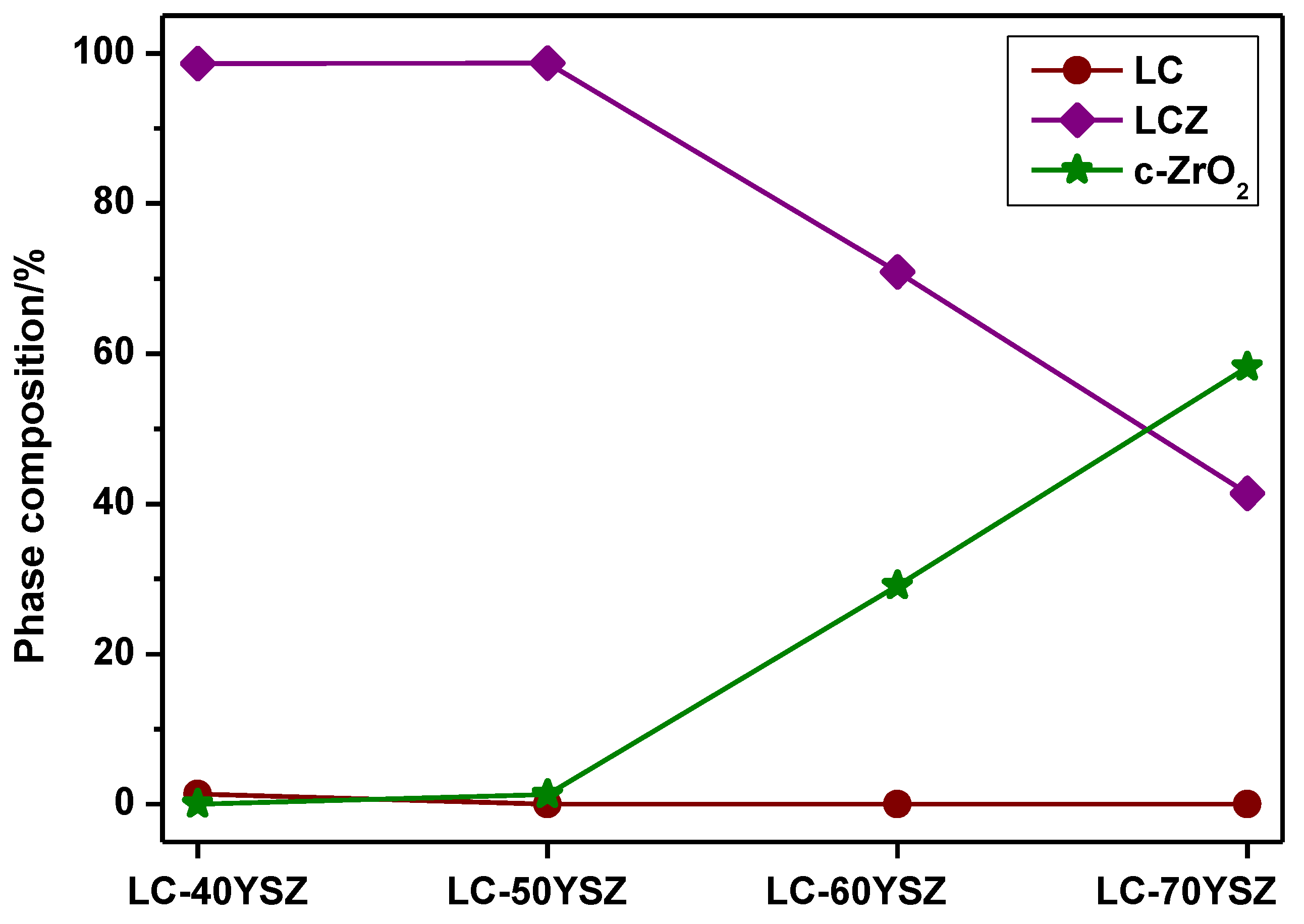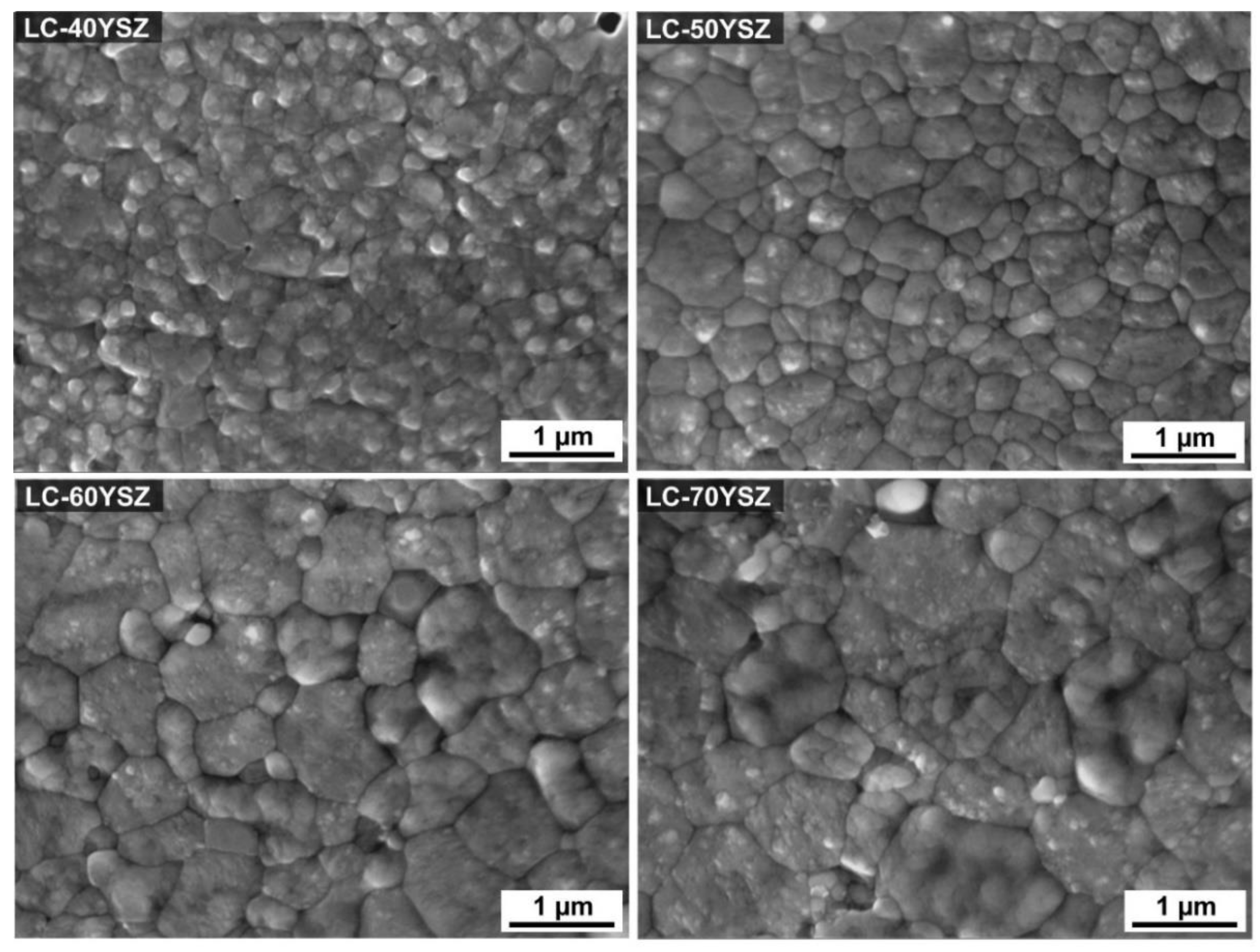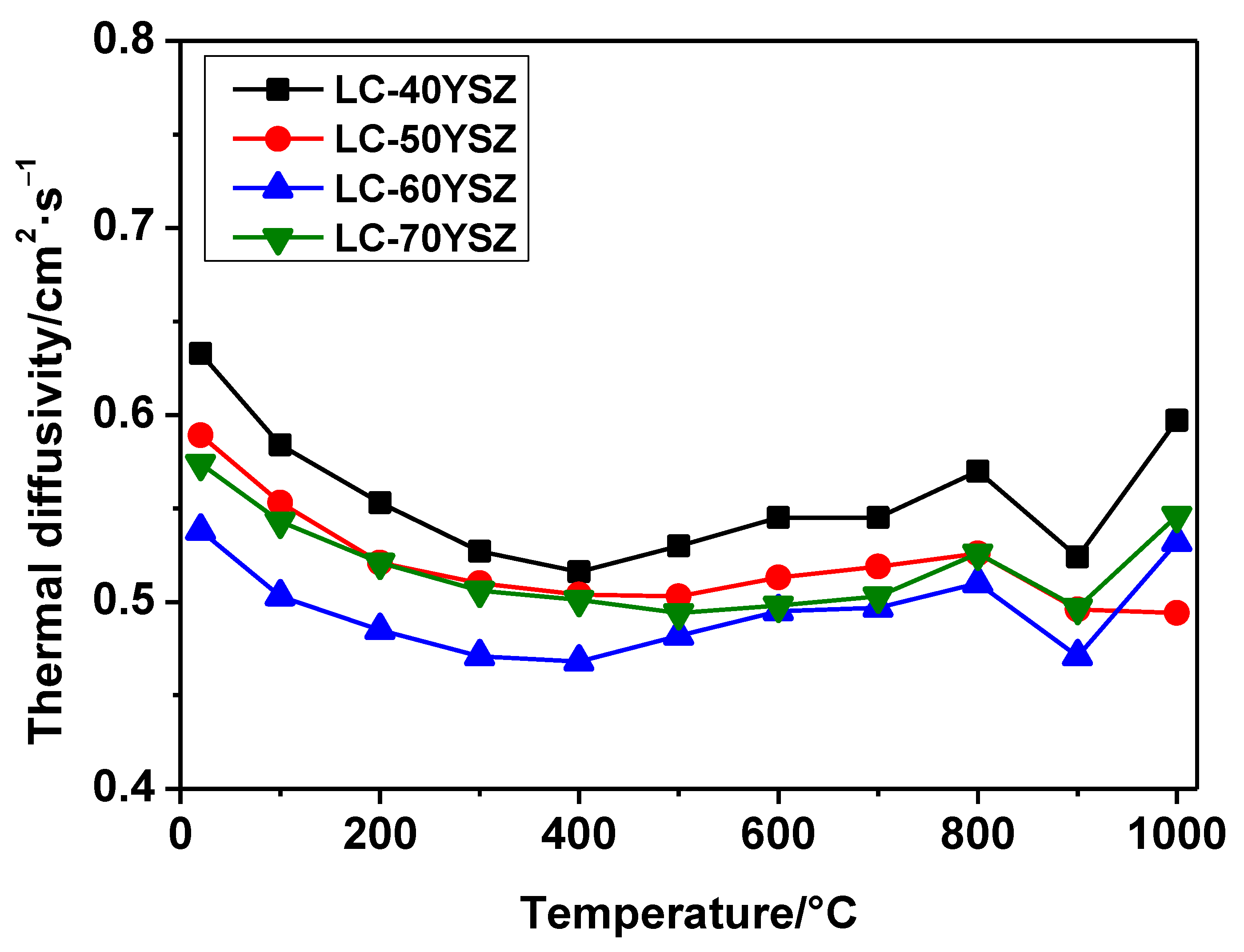Phase Evaluation, Mechanical Properties and Thermal Behavior of Hot-Pressed LC-YSZ Composites for TBC Applications
Abstract
:1. Introduction
2. Materials and Methods
2.1. Preparation of Powders and Composites
2.2. Microstructure Analysis
2.3. Mechanical Properties Measurements
2.4. Thermal Properties Measurements
3. Results and Discussion
3.1. X-ray Diffraction Analysis (XRD)
3.2. Relative Density and Microstructure Characterization
3.3. Mechanical Properties
3.4. Thermal Properties
4. Conclusions
Author Contributions
Funding
Institutional Review Board Statement
Informed Consent Statement
Data Availability Statement
Acknowledgments
Conflicts of Interest
References
- Pakseresht, A.H. Production, Properties, and Applications of High Temperature Coatings; IGI Global: Hershey, PA, USA, 2018; pp. 1–157. [Google Scholar]
- Pakseresht, A.H.; Saremi, M.; Omidvar, H.; Alizadeh, M. Micro-structural study and wear resistance of thermal barrier coating reinforced by alumina whisker. Surf. Coatings Technol. 2019, 366, 338–348. [Google Scholar] [CrossRef]
- Pakseresht, A.H.; Mousavi, S.M.; Saremi, M.; Ghasali, E.; Rajaei, H. Microstructure and mechanical properties of YSZ-alumina composites designed for thermal barrier coatings. Mater. High Temp. 2021, 38, 23–30. [Google Scholar] [CrossRef]
- Pakseresht, A.H.; Rahimipour, M.R.; Alizadeh, M.; Hadavi, S.M.M.; Shahbazkhan, A. Concept of Advanced Thermal Barrier Functional Coatings in High Temperature Engineering Components. In Research Perspectives on Functional Micro- and Nanoscale Coatings; IGI Global, 1AD: Hershey, PA, USA, 2016; pp. 396–419. [Google Scholar]
- Dippong, T.; Levei, E.A.; Cadar, O.; Goga, F.; Borodi, G.; Barbu-Tudoran, L. Thermal behavior of CoxFe3−xO4/SiO2 nanocomposites obtained by a modified sol–gel method. J. Therm. Anal. Calorim. 2016, 128, 39–52. [Google Scholar] [CrossRef]
- Dippong, T.; Levei, E.A.; Goga, F.; Petean, I.; Avram, A.; Cadar, O. The impact of polyol structure on the formation of Zn0.6Co0.4Fe2O4 spinel-based pigments. J. Sol-Gel Sci. Technol. 2019, 92, 736–744. [Google Scholar] [CrossRef]
- Dippong, T.; Levei, E.A.; Lengauer, C.L.; Daniel, A.; Toloman, D.; Cadar, O. Investigation of thermal, structural, morphological and photocatalytic properties of CuxCo1-xFe2O4 (0 ≤ x ≤ 1) nanoparticles embedded in SiO2 matrix. Mater. Charact. 2020, 163, 110268. [Google Scholar] [CrossRef]
- Mauer, G.; Jarligo, M.O.; Mack, D.E.; Vaßen, R. Plasma-Sprayed Thermal Barrier Coatings: New Materials, Processing Issues, and Solutions. J. Therm. Spray Technol. 2013, 22, 646–658. [Google Scholar] [CrossRef]
- Vaßen, R.; Jarligo, M.O.; Steinke, T.; Mack, D.E.; Stöver, D. Overview on advanced thermal barrier coatings. Surf. Coatings Technol. 2010, 205, 938–942. [Google Scholar] [CrossRef]
- Pakseresht, A.H.; Rahimipour, M.R.; Vaezi, M.R.; Salehi, M. Thermal plasma spheroidization and spray deposition of barium titanate powder and characterization of the plasma sprayable powder. Mater. Chem. Phys. 2016, 173, 395–403. [Google Scholar] [CrossRef]
- Pakseresht, A.H.; Rahimipour, M.R.; Vaezi, M.R.; Salehi, M. Effect of heat treatment on the microstructure and dielectric properties of plasma-sprayed barium titanate films. Int. J. Mater. Res. 2016, 107, 28–34. [Google Scholar] [CrossRef]
- Wang, Y.; Yang, F.; Xiao, P. Glass-like thermal conductivities in (La1 − x1Yx1)2(Zr1 − x2Yx2)2O7 − x2 (x = x1 + x2, 0 ≤ x ≤ 1.0) solid solutions. Acta Mater. 2012, 60, 7024–7033. [Google Scholar] [CrossRef]
- Vassen, R.; Cao, X.; Tietz, F.; Basu, D.; Sto, D. Zirconates as New Materials for Thermal Barrier Coatings. J. Am. Ceram. Soc. 2000, 83, 2023–2028. [Google Scholar] [CrossRef]
- Krämer, S.; Yang, J.; Levi, C.G. Infiltration-Inhibiting Reaction of Gadolinium Zirconate Thermal Barrier Coatings with CMAS Melts. J. Am. Ceram. Soc. 2008, 91, 576–583. [Google Scholar] [CrossRef]
- Drexler, J.M.; Ortiz, A.L.; Padture, N.P. Composition effects of thermal barrier coating ceramics on their interaction with molten Ca–Mg–Al–silicate (CMAS) glass. Acta Mater. 2012, 60, 5437–5447. [Google Scholar] [CrossRef]
- Cao, X.; Vassen, R.; Fischer, W.; Tietz, F.; Jungen, W.; Stöver, D. Lanthanum-cerium oxide as a thermal barrier-coating material for high-temperature applications. Adv. Mater. 2003, 15, 1438–1442. [Google Scholar] [CrossRef]
- Ma, W.; Gong, S.; Xu, H.; Cao, X. The thermal cycling behavior of Lanthanum-Cerium Oxide thermal barrier coating prepared by EB-PVD. Surf. Coatings Technol. 2006, 200, 5113–5118. [Google Scholar] [CrossRef]
- Ma, W.; Gong, S.; Xu, H.; Cao, X. On improving the phase stability and thermal expansion coefficients of lanthanum cerium oxide solid solutions. Scr. Mater. 2006, 54, 1505–1508. [Google Scholar] [CrossRef]
- Ma, W.; Li, X.; Yin, Y.; Dong, H.; Bai, Y.; Liu, J.; Nan, D.; Wang, J. The mechanical and thermophysical properties of La2(Zr1-xCex)2O7 ceramics. J. Alloys Compd. 2016, 660, 85–92. [Google Scholar] [CrossRef]
- Shen, Z.; Liu, Z.; Huang, Z.; Mu, R.; He, L.; Liu, G. Thermal shock life and failure behaviors of La2Zr2O7/YSZ, La2Ce2O7/YSZ and Gd2Zr2O7/YSZ DCL TBCs by EB-PVD. Mater. Charact. 2021, 173, 110923. [Google Scholar] [CrossRef]
- Gao, L.; Guo, H.; Gong, S.; Xu, H. Plasma-sprayed La2Ce2O7 thermal barrier coatings against calcium-magnesium-alumina-silicate penetration. J. Eur. Ceram. Soc. 2014, 34, 2553–2561. [Google Scholar] [CrossRef]
- Dong, H.; Wang, D.; Pei, Y.; Li, H.; Li, P.; Ma, W. Optimization and thermal cycling behavior of La2Ce2O7 thermal barrier coatings. Ceram. Int. 2013, 39, 1863–1870. [Google Scholar] [CrossRef]
- Wang, Y.; Xiao, P. The phase stability and toughening effect of 3Y-TZP dispersed in the lanthanum zirconate ceramics. Mater. Sci. Eng. A 2014, 604, 34–39. [Google Scholar] [CrossRef]
- Ma, L.; Ma, W.; Sun, X.; Ji, L.; Liu, J.; Hang, K. Microstructures and mechanical properties of Gd2Zr2O7/ZrO2(3Y) ceramics. J. Alloys Compd. 2015, 644, 416–422. [Google Scholar] [CrossRef]
- Ma, W.; Dong, H.; Guo, H.; Gong, S.; Zheng, X. Thermal cycling behavior of La2Ce2O7/8YSZ double-ceramic-layer thermal barrier coatings prepared by atmospheric plasma spraying. Surf. Coatings Technol. 2010, 204, 3366–3370. [Google Scholar] [CrossRef]
- Bai, Y.; Fan, W.; Liu, K.; Kang, Y.X.; Gao, Y.; Ma, F. Gradient La2Ce2O7/YSZ thermal barrier coatings tailored by synchronous dual powder feeding system. Mater. Lett. 2018, 219, 55–58. [Google Scholar] [CrossRef]
- Liu, X.Y.; Wang, X.Z.; Javed, A.; Zhu, C.; Liang, G.Y. The effect of sintering temperature on the microstructure and phase transformation in tetragonal YSZ and LZ/YSZ composites. Ceram. Int. 2016, 42, 2456–2465. [Google Scholar] [CrossRef]
- Liu, X.Y.; Yi, H.; Che, J.W.; Liang, G.Y. Phase, compositional, structural, and chemical stability of La2Ce2O7 after high temperature heat treatment. Ceram. Int. 2019, 45, 5030–5035. [Google Scholar] [CrossRef]
- Shetty, D.K.; Wright, I.G.; Mincer, P.N.; Clauer, A.H. Indentation fracture of WC-Co cermets. J. Mater. Sci. 1985, 20, 1873–1882. [Google Scholar] [CrossRef]
- Brisse, F.; Knop, O. Pyrochlores. II. An investigation of La2Ce2O7 by neutron diffraction. Can. J. Chem. 1967, 45, 609–614. [Google Scholar] [CrossRef]
- Dehkharghani, A.M.F.; Rahimipour, M.R.; Zakeri, M. Crystal Structure and Lattice Parameter Investigation of La 3 + Substituted CeO2 in LaxCe1-xO2-X/2 Synthesized by Solid-State Method. Adv. Ceram. Prog. 2020, 6, 43–48. [Google Scholar]
- Shannon, R.D. Revised effective ionic radii and systematic studies of interatomic distances in halides and chalcogenides. Acta Crystallogr. Sect. A 1976, 32, 751–767. [Google Scholar] [CrossRef]
- Dehkharghani, A.M.F.; Rahimipour, M.R.; Zakeri, M. Improving the thermal shock resistance and fracture toughness of synthesized La2Ce2O7 thermal barrier coatings through formation of La2Ce2O7/YSZ composite coating via air plasma spraying. Surf. Coatings Technol. 2020, 399, 126174. [Google Scholar] [CrossRef]
- Zhang, H.; Yuan, J.; Song, W.; Zhou, X.; Dong, S.; Duo, S.; Wang, J.; Yang, X.; Jiang, J.; Deng, L.; et al. Composition, mechanical properties and thermal cycling performance of YSZ toughened La2Ce2O7 composite thermal barrier coatings. Ceram. Int. 2020, 46, 6641–6651. [Google Scholar] [CrossRef]
- Ma, W.; Gong, S.; Li, H.; Xu, H. Novel thermal barrier coatings based on La2Ce2O7/8YSZ double-ceramic-layer systems deposited by electron beam physical vapor deposition. Surf. Coatings Technol. 2008, 202, 2704–2708. [Google Scholar] [CrossRef]
- Xu, Y.X.; Liu, T.; Yang, G.J.; Li, C.J. Thermal stability of plasma-sprayed La2Ce2O7/YSZ composite coating. Ceram. Int. 2016, 42, 7950–7961. [Google Scholar] [CrossRef]
- Ohmori, A. Thermal spraying: Current status and future trends. In Proceedings of the 14th International Thermal Spray Conference, Kobe, Japan, 22–26 May 1995; High Temperature Society of Japan: Osaka, Japan, 1995. [Google Scholar]
- Zhang, H.; Sun, J.; Duo, S.; Zhou, X.; Yuan, J.; Dong, S.; Yang, X.; Zeng, J.; Jiang, J.; Deng, L.; et al. Thermal and mechanical properties of Ta2O5 doped La2Ce2O7 thermal barrier coatings prepared by atmospheric plasma spraying. J. Eur. Ceram. Soc. 2019, 39, 2379–2388. [Google Scholar] [CrossRef]
- Yin, Y.; Rioux, R.M.; Erdonmez, C.K.; Hughes, S.; Somorjal, G.A.; Alivisatos, A.P. Formation of Hollow Nanocrystals Through the Nanoscale Kirkendall Effect. Science 2004, 304, 711–714. [Google Scholar] [CrossRef] [Green Version]
- Paul, A. Growth mechanism of phases, Kirkendall voids, marker plane position, and indication of the relative mobilities of the species in the interdiffusion zone. J. Mater. Sci. Mater. Electron. 2011, 22, 833–837. [Google Scholar] [CrossRef]
- Parchovianský, M.; Galusek, D.; Sedláček, J.; Švančárek, P.; Kašiarová, M.; Dusza, J.; Šajgalík, P. Microstructure and mechanical properties of hot pressed Al2O3/SiC nanocomposites. J. Eur. Ceram. Soc. 2013, 33, 2291–2298. [Google Scholar] [CrossRef]
- Mercer, C.; Williams, J.R.; Clarke, D.R.; Evans, A.G. On a ferroelastic mechanism governing the toughness of metastable tetragonal-prime (t) yttria-stabilized zirconia. Proc. R. Soc. A Math. Phys. Eng. Sci. 2007, 463, 1393–1408. [Google Scholar] [CrossRef]
- Tsipas, S.A. Effect of dopants on the phase stability of zirconia-based plasma sprayed thermal barrier coatings. J. Eur. Ceram. Soc. 2010, 30, 61–72. [Google Scholar] [CrossRef]
- Zhang, Y.; Guo, L.; Zhao, X.; Wang, C.; Ye, F. Toughening effect of Yb2O3 stabilized ZrO2 doped in Gd2Zr2O7 ceramic for thermal barrier coatings. Mater. Sci. Eng. A 2015, 648, 385–391. [Google Scholar] [CrossRef]
- Liu, Y.; Bai, Y.; Li, E.; Qi, Y.; Liu, C.; Dong, H.; Jia, R.; Ma, W. Preparation and characterization of SrZrO3–La2Ce2O7 composite ceramics as a thermal barrier coating material. Mater. Chem. Phys. 2020, 247, 122904. [Google Scholar] [CrossRef]
- Kwak, K.H.; Shim, B.C.; Lee, S.M.; Oh, Y.S.; Kim, H.T.; Jang, B.K.; Kim, S. Formation and thermal properties of fluorite-pyrochlore composite structure in La2(ZrxCe1 − x)2O7 oxide system. Mater. Lett. 2011, 65, 2937–2940. [Google Scholar] [CrossRef]
- Xiang, J.; Chen, S.; Huang, J.; Zhang, H.; Zhao, X. Phase structure and thermophysical properties of co-doped La2Zr2O7 ceramics for thermal barrier coatings. Ceram. Int. 2012, 38, 3607–3612. [Google Scholar] [CrossRef]
- Zhang, H.S.; Wei, Y.; Li, G.; Chen, X.G.; Wang, X.L. Investigation about thermal conductivities of La2Ce2O7 doped with calcium or magnesium for thermal barrier coatings. J. Alloys Compd. 2012, 537, 141–146. [Google Scholar] [CrossRef]
- Zhang, D.; Liao, K.; Yu, Y.; Tian, Z.; Cao, Y. Microstructure and thermal & mechanical properties of La2Zr2O7@YSZ composite ceramic. Ceram. Int. 2020, 46, 4737–4747. [Google Scholar]










| Composition | LC (wt.%) | YSZ (wt.%) | LC (mol.%) | YSZ (mol.%) |
|---|---|---|---|---|
| LC-40YSZ | 60 | 40 | 44 | 56 |
| LC-50YSZ | 50 | 50 | 34 | 66 |
| LC-60YSZ | 40 | 60 | 26 | 74 |
| LC-70YSZ | 30 | 70 | 18 | 82 |
| Sample | Relative Density (%) | Average Grain Size (µm) |
|---|---|---|
| LC-40YSZ | 97.7 | 0.5 ± 0.2 |
| LC-50YSZ | 97.8 | 0.6 ± 0.3 |
| LC-60YSZ | 97.2 | 0.8 ± 0.4 |
| LC-70YSZ | 98.6 | 1.1 ± 0.6 |
Publisher’s Note: MDPI stays neutral with regard to jurisdictional claims in published maps and institutional affiliations. |
© 2022 by the authors. Licensee MDPI, Basel, Switzerland. This article is an open access article distributed under the terms and conditions of the Creative Commons Attribution (CC BY) license (https://creativecommons.org/licenses/by/4.0/).
Share and Cite
Parchovianský, M.; Parchovianská, I.; Hanzel, O.; Netriová, Z.; Pakseresht, A. Phase Evaluation, Mechanical Properties and Thermal Behavior of Hot-Pressed LC-YSZ Composites for TBC Applications. Materials 2022, 15, 2839. https://doi.org/10.3390/ma15082839
Parchovianský M, Parchovianská I, Hanzel O, Netriová Z, Pakseresht A. Phase Evaluation, Mechanical Properties and Thermal Behavior of Hot-Pressed LC-YSZ Composites for TBC Applications. Materials. 2022; 15(8):2839. https://doi.org/10.3390/ma15082839
Chicago/Turabian StyleParchovianský, Milan, Ivana Parchovianská, Ondrej Hanzel, Zuzana Netriová, and Amirhossein Pakseresht. 2022. "Phase Evaluation, Mechanical Properties and Thermal Behavior of Hot-Pressed LC-YSZ Composites for TBC Applications" Materials 15, no. 8: 2839. https://doi.org/10.3390/ma15082839






